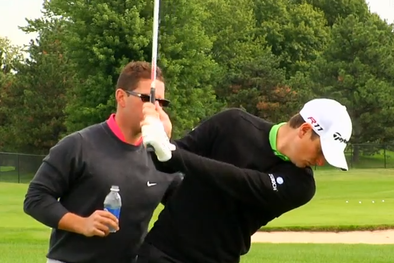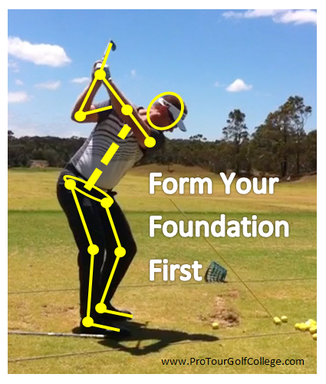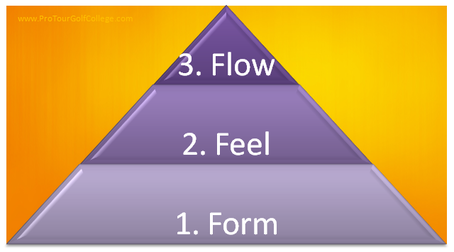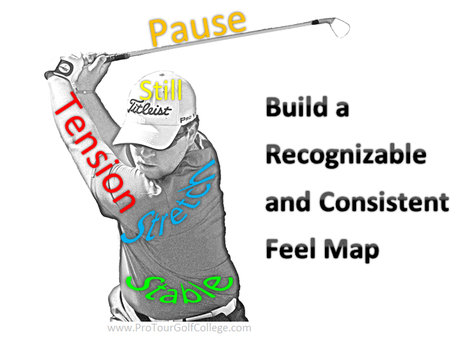How to Practice Golf: The Three Critical Steps to a Successful and Permanent Golf Swing Change26/1/2013
 Do you struggle to successfully make changes to your golf swing? If you’re like many motivated amateur and professional golfers striving to improve, you take golf lessons to improve aspects of your golf skills so that the outcome is better shot-making and lower golf scores. When you want to change the relative position of a body part in your golf swing to improve how it performs,the goal is to perform it enough times to develop a consistent and reliable ‘feel’ in your golf swing. Golfers and instructors use the term ‘feel’ a lot when describing the sensation of swinging the golf club a certain way. The feel of your golf stroke describes it motion and direction and technically is referred to as proprioception. Proprioception describes your ability as a golfer to sense the location, orientation and motion of your body parts when you perform a golf stroke. In effect, the feel of your golf stroke is its reality as opposed to say just viewing your golf swing on a computer screen where you are actually detached from the feeling of the swing motion you’re viewing. In our experience working with thousands of golfers over the years there’s one thing that Dave and I have become pretty sure about. Many golfers spend more time 'looking' at perfecting their swing motion rather than developing it into a recognizable 'feel' that they can confidently repeat and compete with. It is really important that you understand this key distinction in learning if you want to improve your golf skills in a timely fashion.  Feel Without Form is Fickle All golf stroke change must lead to a recognizable feel that is separate from the actual look of the stroke. What I mean is that it is pointless perfecting the look of your golf swing if you cannot translate that into a feel that you can take to the golf course and perform it with a high degree of trust. If you think that trust is a mental skill, you are barking up the wrong tree! Trusting your golf swing is in-fact trusting the feel of your golf swing. And trusting the feel of your golf swing is the only skill that will keep you on the golf improvement pathway. Here’s where it gets tricky because you have to decide on the priority in learning and developing your golf swing technique if you want to give yourself your best chance of learning it. In other words, what come first? Translate Form Into Feel One of my early golf instructors shared with me a very simple philosophy that really helped me to manage the improvement process. “Feel without form first - leads you on a path to nowhere.” What he was saying to me is that you need to get your mechanical platform or foundation right in your mind first, and then you can practice it to develop the feel sensation that allows you to perform it under pressure. You need to understand clearly how what you are changing is going to lead to improvement. In other words you don’t make a change if you don’t understand it first. Many golfers have been down the path of attempting changes in the golf swing technique but because they didn't understand it well enough they couldn't develop the recognizable feel that you ultimately rely on when you perform.  Transfer Feel Into Flow If you don’t understand what you’re trying to do then how can you develop feel and then turn it into flow? Feel into flow is the top of the pyramid in terms of golf swing performance, where you no longer recognize the feel of your golf swing as you have habituated it to such an extent that your golf swing technique flows like a river, smoothly and consistently without conscious thought. At Pro Tour Golf College we describe it with a simple three step approach to help our students to understand the golf stroke change process: Develop the correct FORM – Turn it into a recognizable FEEL - Then let it FLOW Therefore the goal of golf swing change is to develop flow from feel and feel from form. And the best type of feel you can develop is based on a sound mechanical foundation. When you want to make a change to your golf technique from a putt through to a full swing do what the late Stephen Covey suggested as one of his habits in his famous book “The 7 Habit’s of Highly Effective People” and begin with the end in mind. What will your golf stroke look like when you have it where you want it to be? Get clarity around the effect you’re aiming at and then break it down into manageable components. Now each part of the stroke needs repetitions correctly applied until a feel is recognized that you can repeat. This ideally begins without a golf ball in front of you. Start by making the change you’re introducing by standing in front of a mirror or window and learn to understand the feel associated with swinging the golf club the way you’re trying to. You do this by repeating the golf swing motion many times each day correctly. This is why it is essential to have the help of a competent golf instructor to guide you in your development process. The golf instructors primary role is to help you to improve your stroke mechanics, and your responsibility is to practice it into a recognizable feel and ultimately into flow.  Transfer the Old Feeling Map to the New Feeling Map We explain to our students at Pro Tour Golf College that your feel in your golf swing is just like a map with a starting position and an end position. You job is to practice to develop a very definite pathway (feel) that leads consistently to your destination. You need to understand the layout (form) of your map with checkpoints along the way and also trouble spots. When you practice your feel map, perform the golf stroke very slowly at first to accentuate the correct feel so that you can identify how it differs from your original technique map. At this stage it will not be helpful to include a golf ball in the procedure as the golf ball is a distraction that will slow down your improvement process. This is one of the critical mistakes made by many golfers and even golf instructors. The conscious mind can only focus on one thing at a time and it is enough just to focus on correct swing motion without having to also hit a golf ball successfully. It is a recipe for disaster. With the help of your golf instructor design a specific drill (or use a training aid) that can help you to understand the new feel better. Continually get feedback on how the change is coming along by videoing your swing whilst you perform it in slow motion and then at normal speed. Identify the difference in the two swings and keep adjusting your golf stroke until your old technique is overlaid with the new one. You will never completely lose the old stroke pattern, and at times it might even spring back to life, particularly if you stop practicing your new feel map. There is nothing easy about changing a stroke pattern and it requires consistent application with a sharp focus on performing each repetition as correctly as possible for many months. If you follow the three steps I’m suggesting carefully and spend ample time truly learning to understand the correct feel required to transfer your technique to the flow state then before you know it you’ll be using your new technique and enjoying a higher level of performance and enjoyment for many years to come. Lawrie Montague and David Milne – Pro Tour Golf College Your Success On Tour is Our Business
John Roche Dublin Ireland
26/1/2013 09:29:58 am
Lawrie,David, 26/1/2013 09:36:49 am
Thanks John really appreciate your comments and I'm glad you enjoyed it. Regards Lawrie Comments are closed.
|
Archives
June 2019
|
Proudly Supported By
Copyright © 2011 - 2018 Pro Tour Golf College
Website Managed By Golf Performance Media
All Rights Reserved
Website Managed By Golf Performance Media
All Rights Reserved

 RSS Feed
RSS Feed



